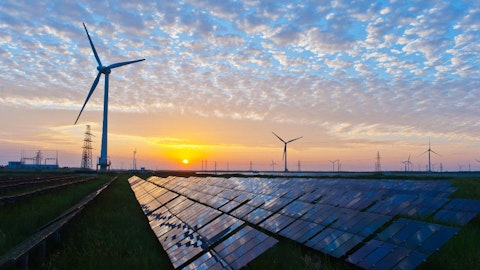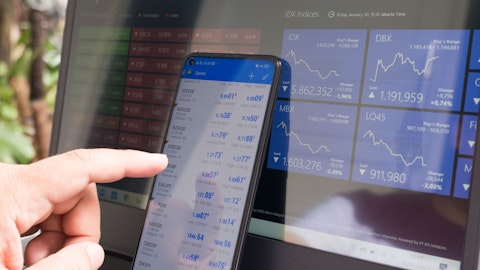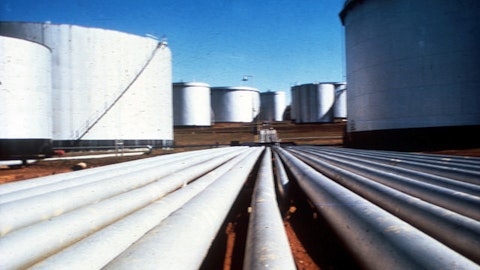Shahriar Pourreza : All right. Let me take the rest off one. I appreciate it, guys. Thank you.
Stephen Westhoven: Alright. Thanks Shah.
Operator: Your next question comes from the line of Chris Ellinghaus with Seibert Williams Shank. Please go ahead.
Chris Ellinghaus : Hey, good morning everybody. Have you guys got any color at this point in terms of the solar CapEx range where you think you might be landing this year?
Roberto Bel: Yes. It is what we’re showing in the presentation, so we’re not deviating from that. So for this year, what we expect for solar is to be between $140 million and $200 million roughly.
Chris Ellinghaus : Have you got a number or some thoughts on what you’re seeing for solar costs, all in per watt at this point?
Stephen Westhoven: Chris, nothing that deviates significantly than what we’ve had historically. I know there’s been some inflationary pressures. We’ve had some hedging in some of our solar panels as well. But we’re continuing to install solar that’s probably around that $2 a watt type range, give or take a few pennies. So hopefully that helps.
Chris Ellinghaus : Yeah, that helps. Through the CSI process this year, have you guys gleaned anything that’s valuable?
Stephen Westhoven: I don’t think the CSI process has been that robust. There’s been some changes to BPU and things like that. So a number of these initiatives have been drawn out a little bit. They’re still working through it. I believe that the bids are all due in February, and then there’s going to be some time to analyze those. So continuing to move along, but really nothing to share as far as kind of a milestone event or some sort of a change or insight into what’s happening next.
Chris Ellinghaus : Okay. One last thing. As far as the rate case goes, is there anything that you are aware of sort of in the BPU environment ecosystem that would suggest sort of a traditional settlement is unlikely?
Patrick Migliaccio : Hey Chris, this is Patrick Migliaccio. As we’ve talked really for quite some time now, this is a vanilla rate case. We’re seeking recovery of investments in safety and reliability. So think pre-’70s pipe and other, as well as some minor recovery for our IT investments. I think if you look across the outcomes that have occurred in a variety of the rate cases, they’ve been constructive. Our historical rate case has been constructive. So I would not expect any deviation from that.
Chris Ellinghaus : Okay, great. That’s helpful. Alright, thanks a lot. I appreciate it.
Operator: [Operator Instructions] And our next question comes from the line of Roger Liddell with Clear Harbor Asset Management. Roger, go ahead.
Roger Liddell: Thank you. Good morning.
Stephen Westhoven: Hey, Roger.
Roberto Bel: Hi, Roger.
Roger Liddell: I wanted to get some texture on the energy efficiency program. To me, it’s asymmetrically important, because it illustrates how far this company has gone beyond the industry standard mindset of, in the old days, the customer was the meter. And you guys have just transformed that kind of old model and the seriousness, the gravamen of the efficiency offerings to me illustrates that point, so it matters. I’m looking at the, call it disconnect between the $60 million of energy efficiency investments and the $482 million, which I believe you said is a three-year program. So how do we get from the $60 million kinds of levels to the aggregate $482 million? And how are you measuring the outcomes of those programs? Is it simply on the investment being made or are there some measurable that you can take back and use for fine tuning the program?
Patrick Migliaccio : Hey. Good morning, Roger. It’s Pat Migliaccio. Thank you for your question and thank you for your long ownership in NJR. Good to hear from you. So I appreciate you acknowledging the role that energy efficiency plays in greenhouse gas emissions. We believe it’s one of the most important things we can do to help drive a reduction in GHG over time. And because we are decoupled, we are able to offer those energy efficiency programs. So that $60 million that you referred to is a significant number, because it’s our largest ever investment in energy efficiency. But that was under the old, same old, Trinium 1 [ph] or Q1 as we refer to it. And so that was a three-year, roughly $39 million program that that spending is being recovered and invested under.
The upcoming Trinium 2, which is the $482 million that you referred to, that includes an increase in the size of certain programs that we normally offer. What we refer to as customized energy programs for small and large commercial customers, but also new elements that are related to building decarburization. And to your point, while we do measure the investment, certainly saving it for our investors, they are also measurable goals related to energy savings that we have to hit as well as part of that approval of that program. I hope that answers your question, Roger.
Roger Liddell: Yes, it does. Thank you. A related question is a year or so ago, the context is hydrogen. Your estimate back then at least was in the range of $8 in MCF equivalent and the contrast with the federal objective of around $2. Is there any progress to speak of? Has that number drifted the right direction?
Stephen Westhoven: The program is still being put together now and some of the rules associated with the taxes and how they are going to apply are coming through. But I think generally speaking, the amount of dollars going towards hydrogen is going to drive down that price of hydrogen with their target price being around $1 a kilogram, which equates to about $8 in MMBTU natural gas. It almost brings it in parity. So we expect it to go in that direction, but those programs are moving forward as we speak and we’ll see in time where it finally ends up.





